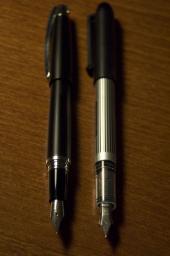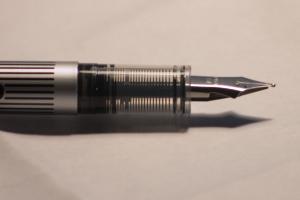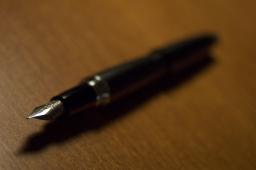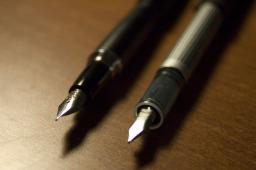
…is my Pilot
 For years I’ve been singing the virtues of the Pilot Varsity, which is a sort of odd duck in both of the worlds it straddles. It is a disposable fountain pen, and so far as I know, it is the only disposable fountain pen. It is by far the most inexpensive fountain pen on the market, but please, lets not call it cheap.
For years I’ve been singing the virtues of the Pilot Varsity, which is a sort of odd duck in both of the worlds it straddles. It is a disposable fountain pen, and so far as I know, it is the only disposable fountain pen. It is by far the most inexpensive fountain pen on the market, but please, lets not call it cheap.
The Varsity is a featherweight of a pen, weighing in at nine grams full of ink and with cap. Some prefer such a light pen, I personally like a bit of heft to my writers. However, I cannot deny that the Varsity is a great writer. The nib glides across paper with just a touch of toothiness, making it as close to ideal a fountain pen as you could ask for. Smoothness and scratchiness is a matter of personal taste (within reason) but most folks like to be able to feel the paper just a little bit. I think it helps the impression of smoothness to feel what little friction there is, to remind you that you’re using something very smooth, rather than something undetectable.
The nib, while not a lot to look at, is simple, functional, and even elegant in its way. The Varsity is a minimalist fountain pen, and the nib seems economical in the best sense of the word. There’s no waste in its flat, angular design.
As far as flexibility, well, we shouldn’t expect miracles. That said, this steel nib is not at all what I would call a nail. It’s absolutely possible to get a bit of flourish and variation to the line with a bit of practice. For the most part, however, it lays down a very even, consistent, unvaried line.
 The section of the pen is really what astonishes me. It’s transparent, showing the feed and what on another pen would be called «comb serrations.» The purpose of these serrations is to regulate the flow of ink, making sure it does not go too fast and leave the pen in a huge blot on your page. While many pens leave that job to a half dozen or so serrations on the underside of the feed, the Varsity has what looks like twenty very tiny discs surrounding the feed on all sides. These discs are protected inside the pen’s section, sealed off where even if ink does overflow it won’t simply drip off.
The section of the pen is really what astonishes me. It’s transparent, showing the feed and what on another pen would be called «comb serrations.» The purpose of these serrations is to regulate the flow of ink, making sure it does not go too fast and leave the pen in a huge blot on your page. While many pens leave that job to a half dozen or so serrations on the underside of the feed, the Varsity has what looks like twenty very tiny discs surrounding the feed on all sides. These discs are protected inside the pen’s section, sealed off where even if ink does overflow it won’t simply drip off.
It’s a very smart design, and accounts for the Varsity’s even flow of ink. Perhaps this design was used because some other part that regulates ink flow is missing, but if so, it is not missed. I’ve had several of these over the past few years and never had a problem with one drying up or leaking. This is a lot more than I can say for many pens ten or twenty times the price.
The nib is available only in a medium, but like most Japanese pens, they run on the fine side of what can be expect from an American or European pen. I’d say it splits the difference between the fine and medium points of a Waterman or Parker fountain pen.
The Varsity is convenient, reliable, and low-maintenance. Being a disposable pen, of course there’s not a lot of choice for ink. I’ve heard that someone has devised a hack to refill the Varsity, which would permit any variety of inks to be used, but frankly, while I like the Varsity, I don’t like it enough to go to the effort to refill one. I can keep one around anywhere, lend it out, leave it on a table with a guestbook and not be concerned that it might disappear. I can leave one in my pocket or pretty much anywhere. I cannot say the same for most of my other fountain pens.
At about three dollars, the Varsity is a great starter pen for someone who isn’t sure whether they would enjoy using a fountain pen, or for someone who has gotten so hooked on fountain pens that a disposable ballpoint is out of the question. It’s not substantial, will never be a family heirloom and is not at all a work of art. Instead it’s a humble, practical and dependable writing instrument that despite it’s light weight is a pleasure to write with.
 If you like the Varsity, let me introduce you to its big brother. This is the Pilot Knight. The Knight carries a suggested retail price of $45 but can be found for around $35. The Knight then is an order of magnitude more pricey than the Varsity. Compared with other fountain pens of the Knight’s quality, design, materials, and workmanship, it’s an absolute steal. In general terms the Knight is easily the equal or better of a Rotring Newton, Waterman Hemishpere, Parker Sonnet (steel-nibbed variety), Cross ATX or Shaeffer Prelude, all pens that carry price tags half again to double or more the Knight’s. These examples may have specific qualities that one prefers to the Knight, but there is no arguing that the Knight is a pen in a class above its price.
If you like the Varsity, let me introduce you to its big brother. This is the Pilot Knight. The Knight carries a suggested retail price of $45 but can be found for around $35. The Knight then is an order of magnitude more pricey than the Varsity. Compared with other fountain pens of the Knight’s quality, design, materials, and workmanship, it’s an absolute steal. In general terms the Knight is easily the equal or better of a Rotring Newton, Waterman Hemishpere, Parker Sonnet (steel-nibbed variety), Cross ATX or Shaeffer Prelude, all pens that carry price tags half again to double or more the Knight’s. These examples may have specific qualities that one prefers to the Knight, but there is no arguing that the Knight is a pen in a class above its price.
The Knight’s nib, like the Varsity’s, comes only in a medium. As stated before, Pilot’s medium point is certainly suitable for those preferring a fine. A look at the nib shows some basic similarity to the Varsity. It has economical lines, made more elegant than the Varsity’s with the rounding of corners and a smoother polish. The Knight’s nib writes smoothly and reliably like its smaller sibling. The qualities of smoothness with a sensitivity to the texture of the paper mentioned regarding the Varsity apply here to an even greater degree. Writing with the Knight is like a trip on a mountain road in a car with a sport-tuned suspension. The pen glides over texture rather than insulating the writer from the texture.
Unlike the Varsity, the Knight is not a disposable and comes with a squeeze-style sac converter. Pilot/Namiki cartridges are available, but I prefer the converter.
The Knight weighs in at 36 grams with the cap or 21 grams without, making it much more my kind of pen. The weight of the Knight rests in my hand nicely; I’ve never been the sort who wants to forget there’s a pen in my hand. The balance is good and the pen feels solid and trustworthy. The clip on the cap is substantial and looks as though it could not be bent. A tug on the clip reveals that it is on a sprung hinge the pivot of which is near the opposite side of the cap. The pen will withstand serious damage before that clip bends.
The only shortcoming I can attribute to the Knight is the overly short section. There’s a pretty short space between the nib and the ridge the cap snaps to, and the step in width from the barrel to section means the options for gripping the pen are limited. I use the Knight with my index finger on the section and my thumb on the barrel. With most pens my thumb and forefinger are closer to opposite one another, but the adjustment is minor and not at all troublesome.
The section is not transparent and I have not disassembled the Knight far enough to see how the ink flow is regulated, but I have not had any trouble with the Knight. It’s on the dry side of moderate as a writer, but never threatens to stop — unless it has run dry, of course.
The Knight’s nib is certainly stiff, but not so stiff that you can’t get some personality from your line when you want to. At the same time, when you want a clean, consistent line it cheerfully delivers exactly that.
These two pens have a great many differences but also a great many similarities. I would not hesitate to recommend either. The bang for the buck cannot be matched, which is not to say that these are bargain pens. Yes, there are compromises with the Varsity’s design that permit it to be produced inexpensively, but both pens are manufactured with enough precision and designed so well that they can be relied upon not only for function, but to provide a pleasurable writing experience. Remember that Namiki, the company that makes Pilot pens, makes fountain pens priced in excess of ten thousand dollars. It’s heartening then that they are versed enough with their craft that the pens they make for us regular folk are simply excellent. It’s encouraging that to at least one company, inexpensive means straightforward and functional rather than cheap.
Pilot Varsity: 9 grams
Pilot Knight: 36 grams

Don’t forget the Pilot Petit
Don’t forget the Pilot Petit 1. Can be disposable, but you can also buy the refills and they comes in lots of colors. I had a few of these, but I seem to have lost all but one. They sell them at the Kinokuniya stationery store in J‑town.
Refilling the Varsity
I realize this is an old article, but refilling the Varsity is rather easy. See:
http://peninkcillin.blogspot.com/2011/07/how-to-refill-your-pilot-varsity.html (not my blog, no affiliation)
I refilled one of mine recently – I consider “disposable fountain pen” to be an oxymoron. 🙂 Plus, it makes it seem too much like a Bic stick.